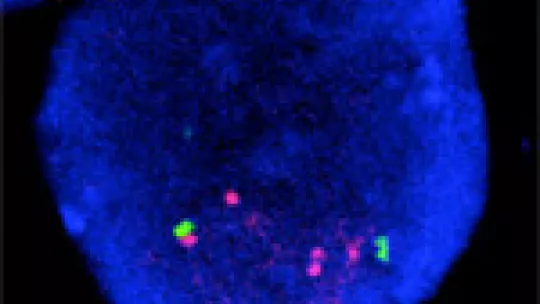Images
Scientists at IRB Barcelona have provided new data on how certain types of aggressive breast cancer bypass tumour suppression mechanisms.
About 30% of breast cancer patients have tumours that show rapid growth and invasion through the body. A common denominator in all of these cases is the presence of a large number of Her2 proteins in tumour cellular membranes. Consequently, these aggressive tumours are referred to as HER2+. Scientists working in the Metastasis Laboratory (MetLab) at IRB Barcelona headed by ICREA researcher Roger Gomis, have described the molecular mechanism that induces HER2+ tumours to ignore the signals that protect cells from excessive growth. The study is published this week in the specialized journal Cancer Research.
Certain external molecules bind to the Her family proteins, thus instructing the cell to divide. However, when cells have multiple copies of the Her2 gene, as is the case of HER2+ patients, they show uncontrolled division and do not respect the signals from their milieu. The prospects for HER2+ patients changed dramatically about ten years ago when the drug Herceptin came onto the market. This agent binds to Her2 to inhibit its proliferative activity, thereby leading to an improved prognosis and greater survival.
LIP disobeys the body’s defense system
When cells detect potential harm, they activate a series of protective responses which often lead to cell death or senescence (no growth). All these mechanisms are systems through which the cell can avoid the irreversible errors that lead them to generate tumours. This explains why tumour cells are removed from the body and replaced by healthy ones. In this context, tumour suppression mechanisms are of particular relevance, among these that induced by the hormone TGF-β and the senescence caused by genes that contribute to the development of malignant cells (OIS).
Through experiments using metastatic cells from patients and animal models, the researchers have discovered that Her2 not only accelerates cell division but also evades these cell arrest systems. Her2 stimulates the production of the protein Lip, which deactivates the mechanisms that prevent cell division mediated by TGF-β and the senescence mediated by OIS, thereby leading to accelerated division. “Lip is the baddie in the film. It affects TGF-β and OIS function, both tumour suppression mechanisms”, explains Gomis.
Towards more rational drug administration
One of the problems associated with Herceptin is that after long periods of treatment patients begin to develop drug resistance. This study shows that tumour cells that produce an excess of Lip continue to grow in the presence of the drug. This observation indicates that part of the resistance derives from the increase in Lip shown by these individuals.
"In patients that have an alteration in Her2 plus an increase in Lip, treatment with Herceptin may not be as effective. It should be remembered that this drug acts only against the membrane protein Her2", explains Gomis. These discoveries highlight the need to rationalise drug administration, from patient to patient, and to provide new data for the design of novel pharmaceutical agents against cancer that improve its diagnosis and treatment.
This study has involved the collaboration of Joan Massagué, Chairman of the Cancer Biology and Genetics Program at the Memorial Sloan-Kettering Cancer Center, New York City, assessor to the MetLab at IRB Barcelona, and adjunct director of the same institute, and has been supported by funding from the BBVA Foundation and the Ministry of Science and Innovation.
Reference article:
HER2 Silences Tumor Suppression in Breast Cancer Cells by Switching Expression of C/EBPb Isoforms
Anna Arnal-Estapé, Maria Tarragona, Mònica Morales, Marc Guiu, Cristina Nadal, Joan Massagué and Roger R. Gomis.
Cancer Research (2010) [DOI: 10.1158/0008-5472.CAN-10-0869]
About IRB Barcelona
The Institute for Research in Biomedicine (IRB Barcelona) pursues a society free of disease. To this end, it conducts multidisciplinary research of excellence to cure cancer and other diseases linked to ageing. It establishes technology transfer agreements with the pharmaceutical industry and major hospitals to bring research results closer to society, and organises a range of science outreach activities to engage the public in an open dialogue. IRB Barcelona is an international centre that hosts 400 researchers and more than 30 nationalities. Recognised as a Severo Ochoa Centre of Excellence since 2011, IRB Barcelona is a CERCA centre and member of the Barcelona Institute of Science and Technology (BIST).





